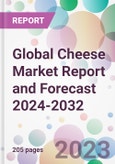According to the report, the global cheese market is projected to grow at a CAGR of 7.8% between 2024 and 2032 reaching a value of approximate USD 164.53 billion by 2032. Aided by the evolving global culinary landscape and a rising fondness for dairy-based products, the market is expected to grow significantly by 2032.
Cheese, a revered culinary delight for centuries, is crafted from the coagulation of milk protein casein. It's a dense source of various nutrients, including calcium, protein, phosphorus, and fat. Originating from various regions and cultures, the diversity in cheese types - from Cheddar to Brie, Mozzarella to Roquefort - is as rich as its history. This diverse palate ensures that cheese finds its place in various cuisines, from being a primary ingredient in gourmet dishes to a simple sandwich spread.
One of the primary accelerators of the global cheese market growth is the shifting gastronomic preferences of the global populace. The globalisation of food trends, facilitated by travel and digital media, has resulted in a global appreciation for cheese-centric dishes like pizzas, pastas, fondues, and cheeseburgers. As these dishes make regular appearances on dining tables worldwide, the demand for cheese continues to soar.
The health and nutrition sector further boosts the cheese market demand. As consumers become more health-conscious, there's an increasing recognition of cheese as a rich protein source. Fitness enthusiasts and bodybuilders often include cheese in their diet for muscle building and repair, thanks to the slow-digesting protein, casein, that it offers.
Beyond culinary uses, cheese also finds applications in various industrial sectors, reminiscent of the diverse uses of its primary protein, casein. In the world of processed foods, cheese acts as a flavour enhancer, texture agent, and primary ingredient in many snacks and convenience foods. Cheese's melting and stretching properties, especially varieties like mozzarella, make it indispensable in the fast-food industry.
Furthermore, the convenience of modern retail, including e-commerce platforms, provides easy access to a diverse range of cheeses, previously limited to specific regions, thus positively impacting the cheese market outlook. A consumer in Asia can now effortlessly relish a European artisanal cheese, thanks to global distribution networks and efficient supply chains.
Cheese, a revered culinary delight for centuries, is crafted from the coagulation of milk protein casein. It's a dense source of various nutrients, including calcium, protein, phosphorus, and fat. Originating from various regions and cultures, the diversity in cheese types - from Cheddar to Brie, Mozzarella to Roquefort - is as rich as its history. This diverse palate ensures that cheese finds its place in various cuisines, from being a primary ingredient in gourmet dishes to a simple sandwich spread.
One of the primary accelerators of the global cheese market growth is the shifting gastronomic preferences of the global populace. The globalisation of food trends, facilitated by travel and digital media, has resulted in a global appreciation for cheese-centric dishes like pizzas, pastas, fondues, and cheeseburgers. As these dishes make regular appearances on dining tables worldwide, the demand for cheese continues to soar.
The health and nutrition sector further boosts the cheese market demand. As consumers become more health-conscious, there's an increasing recognition of cheese as a rich protein source. Fitness enthusiasts and bodybuilders often include cheese in their diet for muscle building and repair, thanks to the slow-digesting protein, casein, that it offers.
Beyond culinary uses, cheese also finds applications in various industrial sectors, reminiscent of the diverse uses of its primary protein, casein. In the world of processed foods, cheese acts as a flavour enhancer, texture agent, and primary ingredient in many snacks and convenience foods. Cheese's melting and stretching properties, especially varieties like mozzarella, make it indispensable in the fast-food industry.
Furthermore, the convenience of modern retail, including e-commerce platforms, provides easy access to a diverse range of cheeses, previously limited to specific regions, thus positively impacting the cheese market outlook. A consumer in Asia can now effortlessly relish a European artisanal cheese, thanks to global distribution networks and efficient supply chains.
Market Segmentation
The market can be divided based on source, type, product, distribution channel, format, and region.Market Breakup by Source
- Cow Milk
- Buffalo Milk
- Goat Milk
- Others
Market Breakup by Type
- Natural
- Processed
Market Breakup by Product
- Mozzarella
- Cheddar
- Feta
- Parmesan
- Roquefort
- Others
Market Breakup by Distribution Channel
- Supermarkets and Hypermarkets
- Convenience Stores
- Speciality Stores
- Online
- Others
Market Breakup by Format
- Slices
- Diced/Cubes
- Shredded
- Blocks
- Spreads
- Liquid
- Others
Market Breakup by Region
- North America
- Europe
- Asia Pacific
- Latin America
- Middle East and Africa
Competitive Landscape
The report looks into the market shares, plant turnarounds, capacities, investments, and mergers and acquisitions, among other major developments, of the leading companies operating in the global cheese market. Some of the major players explored in the report are as follows:- Nestle SA
- Danone S.A.
- Dean Foods Co.
- Lactalis International
- Fonterra Co-operative Group
- Royal FrieslandCampina N.V.
- Arla Foods amba
- Others
Table of Contents
1 Preface2 Report Coverage - Key Segmentation and Scope4 Key Assumptions7 Industry Opportunities and Challenges11 Value Chain Analysis17 Industry Events and Developments
3 Report Description
5 Executive Summary
6 Snapshot
8 Global Cheese Market Analysis
9 Regional Analysis
10 Market Dynamics
12 Price Analysis
13 Manufacturing Process
14 Project Requirement and Cost Analysis
15 Project Economics
16 Competitive Landscape
List of Key Figures and Tables
Companies Mentioned
- Nestle SA
- Danone S.A.
- Dean Foods Co. Lactalis International
- Fonterra Co-operative Group
- Royal FrieslandCampina N.V.
- Arla Foods amba
Methodology

LOADING...








